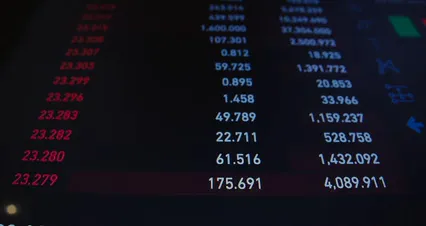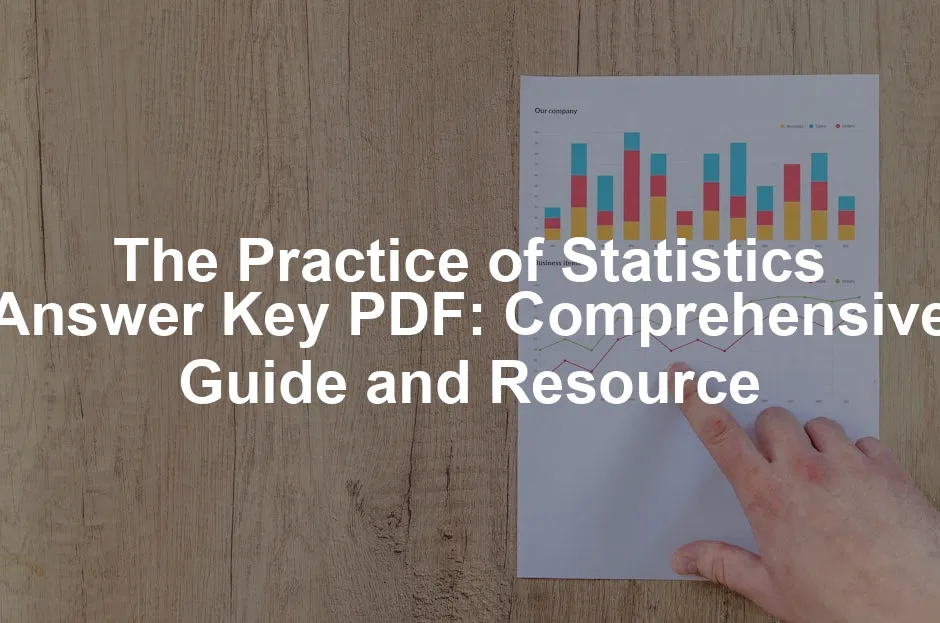Introduction
Statistics is everywhere! It’s the backbone of informed decision-making in both academics and professional settings. Understanding statistics helps you analyze data, identify trends, and make predictions. It’s a skill that’s invaluable in fields such as economics, healthcare, psychology, and social sciences. With the right tools, even the most complex datasets can be transformed into insightful narratives. Textbooks like “The Practice of Statistics” play a crucial role in building this foundation. Written by Daren S. Starnes, Daniel S. Yates, and David S. Moore, this textbook is designed to guide students through the essentials of statistics, filling their brains with critical concepts, techniques, and applications. Whether you’re crunching numbers in a classroom or tackling real-world data, this book equips you with the necessary skills. This article will serve as your comprehensive guide to the answer key for “The Practice of Statistics.” We’ll provide insights into the book’s structure, key topics, and additional resources. By understanding these elements, you’ll be better prepared to tackle the challenges presented in the textbook. Who stands to benefit from this resource? Students grappling with statistical concepts, educators seeking teaching aids, and self-learners eager to enhance their knowledge will all find value here. Whether you’re preparing for an exam or just trying to make sense of statistical methods, this guide is your companion on the journey to statistical proficiency. So, buckle up! We’re about to embark on an enlightening journey through the world of statistics, one answer key at a time.Understanding “The Practice of Statistics”
Overview of the Textbook
“The Practice of Statistics” is a trusted resource for students of all levels. The textbook shines under the authorship of Daren S. Starnes, Daniel S. Yates, and David S. Moore, who have carefully crafted the content to align with educational standards. Available in various editions, including the 4th and 6th editions, this book has been widely adopted across high schools and colleges. Published by Macmillan Higher Education, the 6th edition is particularly noteworthy with the ISBN 9781319113339. This edition incorporates feedback from educators, ensuring that the material is relevant and engaging. It features a plethora of examples, exercises, and visual aids that cater to different learning styles. The structure of the book is designed to guide learners step-by-step through the fundamental principles of statistics. Each chapter builds on the last, allowing students to grasp complex concepts with ease. Whether you’re analyzing data, modeling distributions, or conducting hypothesis tests, this textbook provides a solid foundation. It’s more than just a textbook; it’s a toolkit for understanding the world through data. In the next sections, we’ll break down the chapters and provide a closer look at key topics. This way, you’ll be armed with the knowledge and resources necessary to tackle your statistical challenges head-on. And speaking of challenges, if you’re looking for a solid calculator to assist you, check out the TI-84 Plus CE Graphing Calculator. It’s a lifesaver for statistics students!Chapter Breakdown
Understanding the structure of “The Practice of Statistics” is essential for mastering its content. Each chapter unfolds a new layer of statistical knowledge, making it easier for students to digest complex concepts. Here’s a quick summary of key topics covered in this indispensable textbook. 1. Data Analysis This chapter introduces students to the fundamentals of data analysis. It emphasizes analyzing categorical data and displaying quantitative data using graphs. Students learn how to describe quantitative data with numbers, which is vital for drawing conclusions from datasets. For more insights on data analysis, check out our guide on tips for effective data analysis in economics and statistics. And if you’re in need of a handy Graph Paper Notebook for your calculations, this is the perfect companion!
2. Modeling Distributions of Data In this section, students explore how to describe locations in a distribution. They learn about density curves and normal distributions, which are crucial for understanding how data is spread out. This chapter lays the groundwork for grasping more advanced topics later. 3. Collecting Data Collecting data is like gathering ingredients for a recipe. This chapter covers sampling and surveys and discusses experiments and the importance of using studies wisely. It teaches students the right methods to collect data, ensuring their results are reliable. If you’re looking for a structured approach to collecting data, consider the Statistical Analysis with Excel for Dummies. It’s a great resource for data collection and analysis!Understanding data analysis is crucial for students. tips for effective data analysis in economics and statistics can provide valuable insights.

5. Random Variables This chapter dives into discrete and continuous random variables. Students learn how to transform and combine random variables, and the chapter introduces binomial and geometric random variables. Understanding these concepts is key for performing accurate probability calculations. 6. Inference for Distributions Inference is a critical skill in statistics. This chapter covers confidence intervals and significance tests. Students learn how to make inferences about population parameters based on sample data, allowing them to draw conclusions about broader trends. For those looking to enhance their understanding of hypothesis testing, check our statistics hypothesis testing cheat sheet. And if you’re serious about mastering statistics, don’t forget to get a solid reference book like “The Art of Statistics: Learning from Data” by David Spiegelhalter.Probability is a fundamental concept in statistics. For a deeper understanding, check out our guide on Mendelian genetics probability pedigrees and chi-square statistics.

Each chapter is designed not only to inform but also to engage students. The mix of theory and practical application ensures that learners can relate what they study to real-world scenarios. So, grab your calculator and get ready to tackle the numbers with confidence!Inference is essential for statistical analysis. For more help, refer to our statistics hypothesis testing cheat sheet.
Benefits of Using an Answer Key
Enhancing Learning
Self-Assessment An answer key acts like a trusty sidekick for students. It helps them assess their understanding of complex topics and reinforces their learning process. When students check their answers, they can identify what they’ve mastered and what needs more attention. This instant feedback loop is vital for effective study habits. Effective Study Tool Using an answer key is like having a cheat sheet, minus the guilt! It’s a fantastic tool for exam preparation. Students can practice problems, check their answers, and clarify misunderstandings before test day. The answer key also serves as a homework helper, providing guidance on tricky problems. For those who want to excel, consider pairing your studies with “How to Ace the SAT Math Section” by Thomas E. E. McCarthy for extra practice!
Resources for Accessing Answer Keys
Where to Find Answer Keys Finding answer keys for “The Practice of Statistics” can feel like searching for a needle in a haystack. But fear not! There are several reliable resources to make your life easier. 1. Bartleby Bartleby is a treasure trove for students. It offers various textbooks, including “The Practice of Statistics.” You can access solutions directly through their platform. Here’s a link to check it out: Bartleby Solutions. 2. StudySoup StudySoup is another fantastic resource. They provide step-by-step solutions and helpful study tools to support your learning. Plus, you can find notes and exam guides contributed by fellow students. Explore their offerings here: StudySoup. 3. Scribd Scribd offers a variety of documents, including solution manuals for “The Practice of Statistics.” While they operate on a subscription model, they often provide a free trial period. It’s a great way to access materials without immediate commitment: Scribd Solutions. 4. Other Educational Platforms Consider other educational sites like Course Hero and Chegg. They may not be mentioned specifically here, but they generally offer similar resources that could help you track down the answers you need. Plus, Chegg has great resources for textbooks like “The Cartoon Guide to Statistics”. Cautions About Using Answer Keys While answer keys can be incredibly helpful, they come with a hefty dose of responsibility. Using them wisely is essential to avoid academic dishonesty. Here are a few points to keep in mind: – Study Aid, Not a Shortcut: Use answer keys to check your understanding and reinforce learning. Don’t simply copy answers without attempting the problems first. This approach may leave you unprepared when it matters most—like in exams! – Understand the Material: If you encounter discrepancies between your answers and those in the key, take the time to figure out where you went wrong. This practice deepens your understanding and builds your problem-solving skills. – Consult Your Educators: If you’re unsure about how to use an answer key ethically, don’t hesitate to ask a teacher or tutor. They can provide guidance on effective study habits. Remember, the goal is to learn and grow, not just to finish assignments. Harness the power of answer keys responsibly, and you’ll find yourself mastering statistics in no time!Example Problems and Solutions
Statistics can feel like a wild ride at times, but fear not! We’re here to simplify the chaos. Let’s break down some common statistical problems and the steps to solve them. You’ll soon realize that with a little practice, you can tackle any statistical challenge like a pro! Problem-Solving Steps 1. Mean, Median, Mode Calculations – Mean: This is the average. To find it, add all numbers together and divide by the count of numbers. For example, for the dataset {3, 5, 7}, the mean is (3 + 5 + 7) / 3 = 5. – Median: This is the middle value. First, arrange the numbers in ascending order. If there’s an odd count of numbers, the median is the middle one. If even, it’s the average of the two middle numbers. For {3, 5, 7, 9}, the median is (5 + 7) / 2 = 6. – Mode: This is the number that appears most frequently. In the list {1, 2, 2, 3, 4}, the mode is 2.



Additional Resources and Study Tools
Online Platforms
In the age of digital learning, numerous platforms can assist you in your statistics journey. Here’s a look at some top-notch resources: – StudySoup: This platform is a goldmine for students. It offers comprehensive study tools, including video explanations and community support. With step-by-step solutions available, you can truly understand the reasoning behind each answer. Plus, you can connect with fellow students for collaborative learning. So, if you’re a visual learner or just need clarification on a tricky concept, StudySoup has your back!
Related Textbooks
If you want to expand your statistical knowledge, consider similar textbooks. Titles like “Statistics for Dummies” or “Naked Statistics” offer a more casual approach to complex topics. They break down statistical concepts into digestible nuggets, making learning feel less overwhelming. For more structured guidance, you can explore our comprehensive guide to statistics textbooks.Additionally, it’s crucial to have accessible formats for all students. E-books, audiobooks, and online resources ensure that everyone can dive into the world of statistics, regardless of their learning preferences. So, whether you’re using online platforms for immediate help or exploring additional textbooks for deeper insights, remember that you’re not alone on this statistics adventure. Each resource can guide you toward mastering this essential subject!For a deeper understanding of statistical resources, check out our comprehensive guide to statistics textbooks.
Comparative Analysis
When it comes to mastering statistics, “The Practice of Statistics” isn’t the only game in town. A plethora of related textbooks can deepen your understanding. For instance, “The Complete Idiot’s Guide to Statistics” breaks down complex ideas into easy-to-digest nuggets. It’s perfect for those who may feel overwhelmed by numbers. Another notable title is “The Data Science Handbook: Advice and Insights from 25 Amazing Data Scientists” by Foster Provost and Tom Fawcett. This book offers a witty, accessible approach to statistical concepts. It’s like having a friend explain statistics over coffee—minus the caffeine jitters!
Conclusion
Summary of Key Points Having access to an answer key for “The Practice of Statistics” is vital for any serious student. It acts as a safety net, allowing learners to assess their understanding and clarify misconceptions. With the answer key, students can check their work, ensuring they grasp key concepts before moving forward. Moreover, the myriad of resources discussed in this article—like online platforms and related textbooks—amplifies educational opportunities. They provide multiple avenues for students to engage with statistics in a meaningful way. Final Thoughts As you navigate the world of statistics, remember that resources like answer keys are here to support your learning journey. Embrace the tools at your disposal, and don’t hesitate to explore additional materials. Whether it’s connecting with peers, utilizing online help, or diving into supplementary textbooks, all these efforts contribute to your academic success. Statistics can be daunting, but with the right resources, you can conquer those numbers. So, roll up your sleeves, grab that calculator, and let’s make statistics a little less scary and a lot more enjoyable! And for those who want a comprehensive overview of statistical concepts, consider “The Book of Why: The New Science of Cause and Effect” by Judea Pearl.FAQs
Where can I find the answer key for “The Practice of Statistics”?
You can find the answer key PDF on various platforms. Bartleby offers comprehensive solutions for the 6th edition, making it easy to access answers directly. Check it out here. Additionally, StudySoup provides a wealth of resources, including step-by-step solutions.
Is it ethical to use an answer key for studying?
This is a great question! Using an answer key can be ethical when done responsibly. It’s a tool for reinforcing understanding rather than a shortcut to avoid learning. Just ensure you attempt the problems first and use the key to verify your answers and clarify doubts. Academic integrity is key!
What if I can’t find the answer key for my edition?
If you’re struggling to find the answer key for your specific edition, don’t despair! Consider reaching out to classmates or educators for assistance. You can also check online forums or tutoring services where fellow students may help clarify concepts or provide alternative resources.
Can I get additional help with statistics problems?
Absolutely! Many online platforms offer tutoring services and forums where you can get additional help. Websites like Chegg and Course Hero provide on-demand assistance for statistics problems. You can also consider local tutoring centers or study groups to enhance your understanding and confidence.
All images from Pexels




